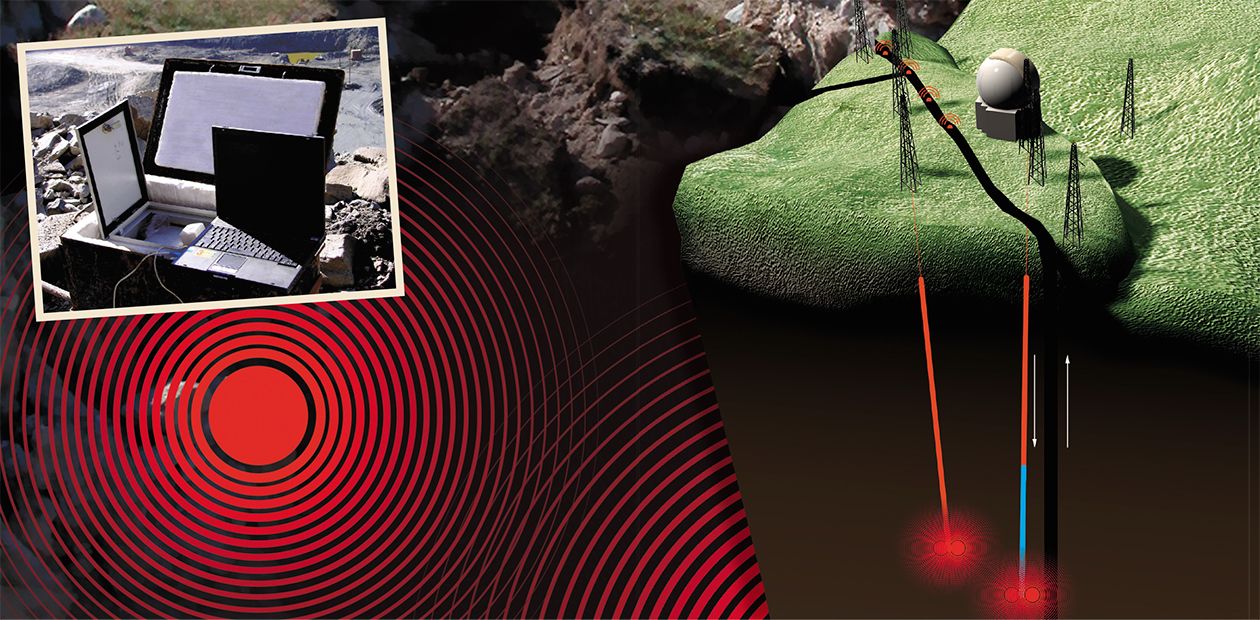A Challenge to Earthquakes
What is man, so small and helpless, against an earthquake, an invincible natural disaster which eludes any control? — Though small and feeble, people of the third millenium are learning to move mountains…
People have been trying to withstand earthquakes since very long ago but, till recently, they have just come to mitigate the devastating consequences of seismic shocks. However, neither seismic risk mapping, nor earthquake-proof engineering, nor salvage improvements, nor the humble progress in earthquake prediction can considerably reduce seismic damage.
Reliable short-term earthquake prediction appears to remain a tough problem in the nearest future. Therefore, scientists from many countries worldwide are looking for alternative working ways to combat seismic risk.
How do earthquakes arise?
The Earth’s crust consists of numerous small, large, and huge blocks cut by small and large fractures and faults; thus, it has a discontinuous block structure, in terms of mechanics. Almost all crustal deformation is largely associated with processes along block boundaries, i.e., along faults.
Devastating earthquakes release only a small portion of strain energy stored in the Earth’s interiorMost scientists today agree that earthquakes arise from quick slip of fault edges. Coseismic slip can reach a rate of 10 m/s or higher. The related vibration of fault walls excites elastic waves of different frequencies, which propagate in rocks. One-to-fifteen-hertz waves are often fatal and produce catastrophic earthquakes, especially if they are accompanied by prompt surface rupture.
It is only very rapid fault motions that can generate strong seismic waves, which fortunately happens quite rarely. During the rest of its life, between the episodes of quick slip, an active fault is subject to a very slow deformation of aseismic creep, or plastic flow, at a rate of 0.1—10 mm/yr.
Deformation in the faulted crust is caused by physical and chemical processes deep in the Earth’s interior and by extraterrestrial energy sources in the solar system. As a result, the Earth stores a great amount of tectonic strain energy, a minor portion (one to five percent) of which is released as destructive seismic waves in devastating earthquakes. Earthquake-induced surface rupture can, in turn, destroy houses and engineering structures and cause mudflow or landslide hazards.
“Slip” has helped
Thus, elastic waves induced by quick slip on fault sides release a few percent of strain energy accumulated in the stressed crust and subcrustal space. What if one ventures to control the motion in hazardous fault parts?
This bold idea has been guiding our studies through the recent decade. It came into practice owing to a precise electronic instrument called Sdvig (Russian for a slip) originally designed at the Institute of the Earth’s Crust (Irkutsk) to measure fault motions in zones of high seismic risk. Its pilot sample equipped with an induction sensor appeared in 1994 and was tested in a fault near the town of Slyudianka on the southern tip of Lake Baikal.
A year later the instrument was upgraded and acquired a special ring sensor. We set up a modified ring ground-motion detector in the Angara active seismic fault, which allowed of long-term precise monitoring (to about 1-2 mcm) of active faulting.
The very first experiments in the Listvyanka site (near the place where the Angara flows into Lake Baikal) gave striking results. Inside the fault, the monitoring revealed continuous and intricate seesaw motions governed by temperature, wind, air pressure and humidity, shocks from local severe earthquakes and, of course, by slow deformation which usually becomes evident in the long run. Fractured rocks, and hence the Angara fault itself, turned out to be highly sensitive to the external impact (Ruzhich et al., 1999), and that was the key discovery. We continued our monitoring with upgraded detectors and saw that even a weak (500—1000 J) dynamic impact on the hierarchically structured faulted crust could appreciably change motions on faults along block boundaries. The response of rocks depended also on the way of loading. It came either right away or from minutes to days later, the late response being prominent and long-lasting.
Further full-size experiments — in the Angara fault and elsewhere — proved that manmade control over the rate and direction of slip is basically feasible.
Water and fire
The fact that fluid injected into rocks can trigger small earthquakes was discovered long ago. For instance, injecting liquid wastes into deep wells provoked a pulse of seismic activity in the form of numerous but small and shallow (4-8 km) events in Denver in 1964.
Thus it became clear that fluid penetrating deep into the crust reactivates motions on faults of different sizes. These motions, in turn, reduce the excess crustal stress due to numerous displacements along cracks induced by water flow, which is usually associated with many small seismic shocks.
Japanese scientists investigated the effect of water injected into the Nojima fault (the causative fault of the severe Kobe event of 1995 in Japan) in carefully prepared experiments carried out in 1997 and 2000. Water injection triggered numerous small shocks which originated at depths below 4 km, deeper than the injection depth, and continued for a few days. Water permeating cracked and porous rocks increased the pore pressure and decreased the stress in the fault. Furthermore, it launched the creep mechanism, or the slow release of deep strain energy by motions along small fractures (Nishigavi et al., 2002).
These experiments show that a safe stress drop in the sources of pending earthquakes does not require 15-20-km-deep drilling; the more so, as the crust contains many underground water systems which can be redirected to the wanted paths. Underground nuclear tests in Nevada (USA) and Semipalatinsk (Kazakhstan, FSU) helped estimate the seismotectonic effects from a high-energy impact. Blasts of dozens to hundreds of kiloton set off in kilometer-deep holes in Nevada caused many-kilometer-long surface ruptures in the nearby fault zones.
Some nuclear blasts induced earthquakes whose energy was one-hundredth or one-thousandth of the energy of the explosions. The impact from explosions apparently facilitates the release of excess crustal stress in small shocks and thus wards off the threatening severe earthquakes (Tarasov and Tarasova, 1995). That is why seismicity in the regions of nuclear tests is of lower energy.
An earthquake “vaccine”
We tried different ways of impact faulting control such as drilling, ramming, explosions, water injection, etc. Among other effects, we discovered that the Angara fault responded to a joint impact produced by wind-caused oscillations of the 25-m-high tower of a solar vacuum telescope and a rain shower during a storm.
The effect of multiple quarry explosions was investigated in the 560-m-deep Udachny quarry in Sakha Republic (Yakutia), with explosives measuring dozens of ton. Similar experiments, but with smaller explosive weights, were run elsewhere in East Siberian faults and in seismogenic faults in Mongolia, the country struck by four devastating earthquakes last century.
Injecting water into seismically hazardous faults or carrying out a series of directed explosions can reduce the magnitude of a pending earthquakeIt should be mentioned that explosions can sometimes cause a quick slip and trigger an earthquake, especially if its natural nucleation is almost complete. Therefore, weak but frequent and long vibrations appear a safer and better controllable way of stress release. The available surface vibrators are hardly suitable for this purpose as the elastic waves they generate rapidly dissipate with depth, their effect on the deep fault parts being too weak. The problem can be solved with special vibrators, and their designing is already underway in Russia.
The storm in Listvyanka prompted the idea that vibration and/or explosions combined with water injection provide all the more efficient faulting control. Full-size experiments in Listvyanka in the Angara fault in 2004—2006 showed very promising results in this respect. In 2004 we smoothly displaced the fault edges by about one centimeter along the oblique-slip motion in just a few days. In natural conditions this displacement would require many decades, with 0.05—0.08 mm/yr creep. The man-induced displacement provided a considerable stress drop in rocks.
In August 2006 the Listvianka site was used to test a new vibration system designed under G. G. Kocharyan at the Institute of Dynamics of Geospheres (Moscow). The system works by exploding an air-gas mixture in a water-filled hole drilled inside a fault; the detonation wave energy exerts a strong pulse impact on the fault and the surrounding rocks. Tests showed that these vibrators, if further advanced, can become the best tool for man-induced faulting control.
The recent eleven years of experiments have made us believe that people are really able to control active faulting. Our method for control of motions in seismogenic faults was patented in 2006 and we received a letters patent of the Russian Federation.
To study in order to take control
Obviously, the reader may wonder whether this unusual approach is feasible on a large scale. It doesn’t seem very hard to control fault motions over dozens of meters near the surface, but dealing with kilometer-deep faults which are dozens of kilometers long is quite a different thing. For instance, earthquakes in the Baikal region most often originate at depths of 10—25 km, where the crust is as hot as 300—700 ° С and the pressure reaches three to seven kilobars.
Release of strain energy in weak but long vibration is the safest way to prevent severe earthquakesLarge-scale practical application of our results poses a number of questions. A key point is to choose safe and workable energy sources that can impact deep fault parts and displace rocks by at least dozens of centimeters, a slip sufficient to reduce the seismic risk in the nearest hundreds of years. Then, we have to make sure that our actions won’t prematurely trigger a severe nucleating earthquake. And, after all, it is important to know whether the regularities we discovered are general and what their governing parameters are.
Problems caused by the lack of direct knowledge of deep seismotectonic processes are resolvable with the help of mathematical modeling and simulation. This modeling has been part of a joint project of the Institute of the Earth’s Crust (Irkutsk) and the Institute of Strength Physics and Material Sciences (Tomsk). The obtained mathematical models and numerical experiments based on the method of mobile cell automates (Psakhie et al., 2000, 2001) showed the generality of our field results and provided a theoretical background for man-induced local stress release in active seismic faults. The same approach is used for rapid estimation during faulting control tests.
A special strategy developed for manmade control over seismically hazardous fault segments implies the continuous monitoring of active deformation, which ensures making prompt corrections if necessary.
Another question the reader may ask is this: How can earthquake fighters learn about the location of a pending severe event? Specialists often know the location of nucleating earthquakes that may threaten large cities, nuclear power stations, dams, etc., though the exact time remains unknown. Yet, the strategy of preventive man-caused impact we suggest does not require authentic short-term prediction. One never needs to wait until an earthquake culminates and arrives at its tectonic final.
There are natural hazards and natural processes. The former, to a large extent, measure the misunderstanding of the latter and the conservatism of human thinking.
If people know the causes and features of a potential natural hazard, they should learn to prevent it.
An efficient man-induced impact on seismically hazardous faults is possible today; it can relieve the Earth’s interior of excess strain energy. It is important that we be aware of this possibility and maintain joint efforts in international projects.
It should be mentioned that scientists and government institutions in Mongolia, Iran, Germany, and Japan have shown interest in the Siberian project for preventing severe earthquakes. Thus, we are looking forward to further experiments and new discoveries on the long and hard way toward the control over the unruly malice of nature.
Photographs by V. Ruzhich










